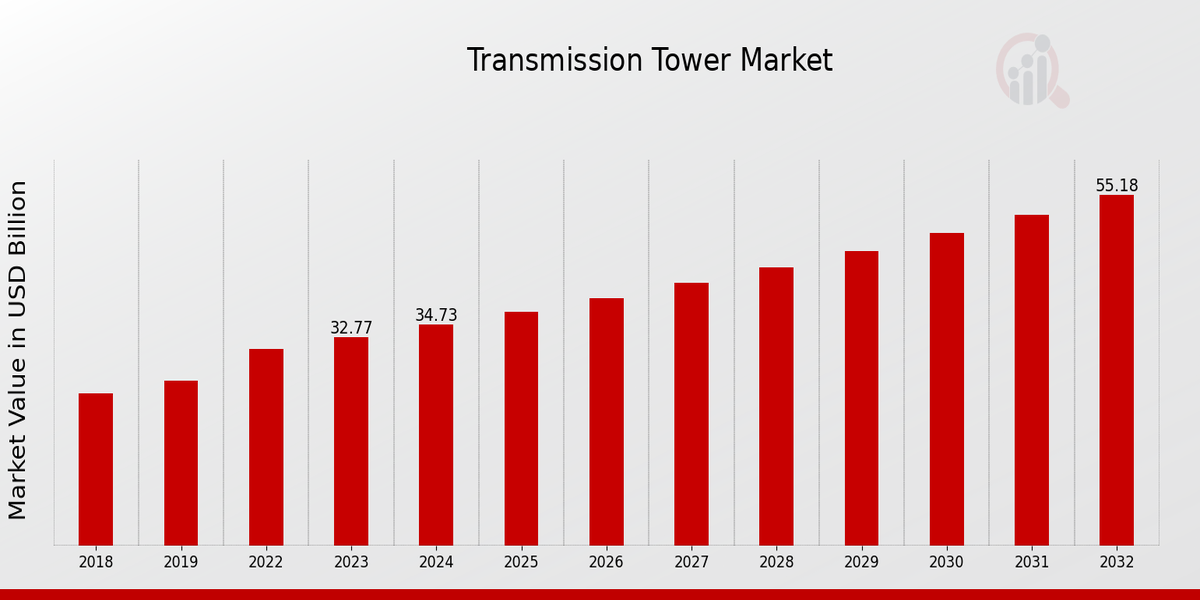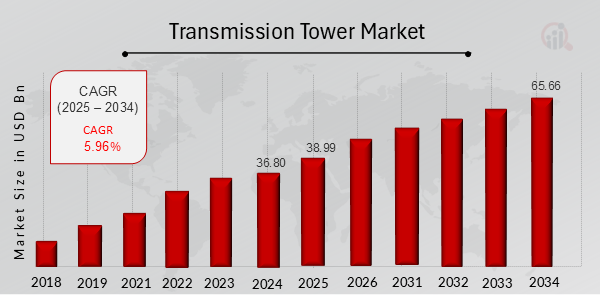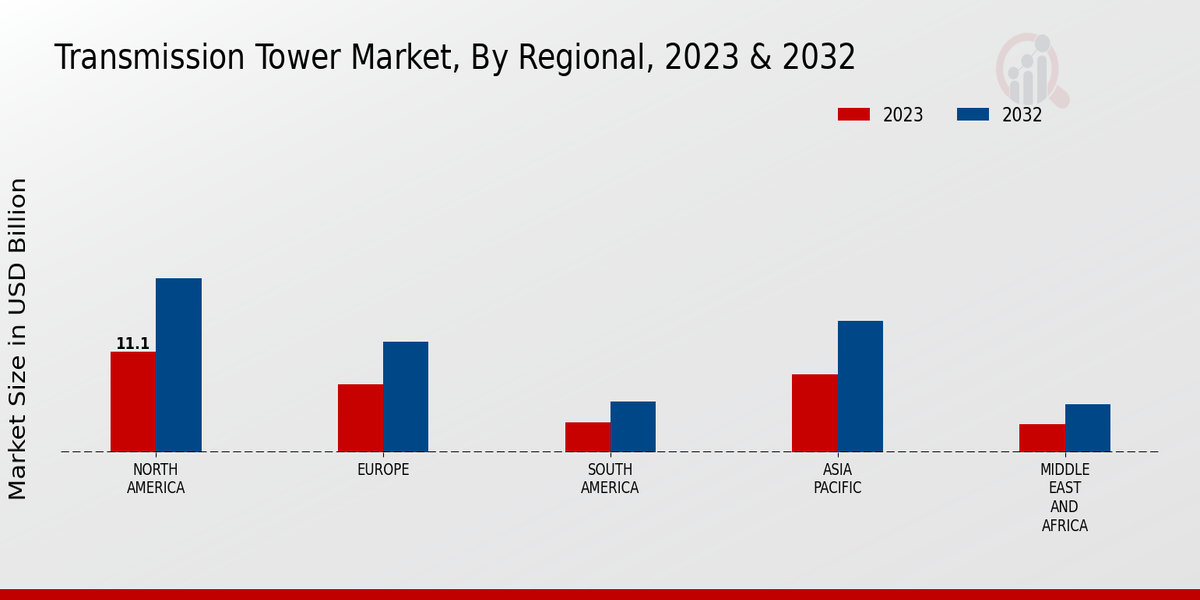Global Transmission Tower Market Overview
As per MRFR analysis, the Transmission Tower Market Size was estimated at 36.80 (USD Billion) in 2024. The Transmission Tower Market Industry is expected to grow from 38.99 (USD Billion) in 2025 to 65.66 (USD Billion) till 2034, at a CAGR (growth rate) is expected to be around 5.96% during the forecast period (2025 - 2034)
Key Transmission Tower Market Trends Highlighted
The Transmission Tower Market has exhibited strong growth in recent times, primarily driven by the increasing demand for electricity as well as the expansion and upgrading of transmission networks. Increasing government initiatives towards infrastructure development, especially in developing countries, offer significant opportunities for market expansion. Renewable energy projects, such as solar and wind farms, require extensive transmission infrastructure, creating a surge in demand for transmission towers. Moreover, the ongoing trend towards digitalization and smart grid technologies further drives market growth, as transmission towers play a vital role in facilitating the integration of renewable energy sources and enhancing grid stability.


Source: Primary Research, Secondary Research, MRFR Database and Analyst Review
Transmission Tower Market Drivers
Increasing Demand for Renewable Energy
The increasing demand for renewable energy, such as solar and wind power, is a major driver of growth in the Transmission Tower Market Industry. Renewable energy sources require efficient and reliable transmission infrastructure to deliver electricity to consumers. Transmission towers play a crucial role in this infrastructure, ensuring the safe and efficient transmission of electricity over long distances. As the world transitions to a cleaner energy mix, the demand for transmission towers is expected to continue to rise.
Expansion and Upgradation of Transmission Networks
The expansion and upgradation of transmission networks is another key driver of growth in the Transmission Tower Market Industry. Developed countries are investing in upgrading their aging transmission infrastructure to improve efficiency and reliability. In developing countries, there is a growing need for new transmission lines to connect remote areas to the grid and support economic development. This expansion and upgradation of transmission networks is creating a significant demand for transmission towers.
Technological Advancements and Innovation
Technological advancements and innovation are also driving growth in the Transmission Tower Market Industry. The development of new materials, such as high-strength steel and composite materials, is enabling the construction of lighter and more durable transmission towers. Advancements in design and engineering are also leading to more efficient and cost-effective tower designs. These technological advancements are helping to reduce the cost of transmission towers and improve their performance, making them more attractive to utilities and other end-users.
Transmission Tower Market Segment Insights
Transmission Tower Market Tower Type Insights
The Transmission Tower Market is segmented by Tower Type into Self-Supporting Towers, Guyed Towers, and Monopole Towers. Self-supporting towers are self-supporting structures that do not require any external support. They are typically used in areas with high wind loads or where there is a need for a strong and stable structure. The global market for Self-Supporting Towers was valued at USD 13.73 billion in 2023 and is expected to grow to USD 23.221 billion by 2032 at a CAGR of 6.1%. Guyed Towers are supported by guy wires, which are tensioned cables that are attached to the ground.
This type of tower is typically used in areas with soft soil conditions or where there is a need for a tall and slender structure. The global market for Guyed Towers was valued at USD 10.499 billion in 2023 and is expected to grow to USD 17.64 billion by 2032 at a CAGR of 6.3%. Monopole Towers are single-pole structures that are used to support antennas and other equipment. They are typically used in urban areas or where there is a need for a space-efficient structure. The global market for Monopole Towers was valued at USD 8.541 billion in 2023 and is expected to grow to USD 14.319 billion by 2032 at a CAGR of 6.5%.
The growth of the Transmission Tower Market is being driven by several factors, including the increasing demand for electricity, the expansion of the power grid, and the need for reliable and efficient transmission of electricity. The increasing demand for electricity is driven by the growing population and the increasing urbanization around the world. The expansion of the power grid is being driven by the need to connect remote areas to the grid and to increase the capacity of the grid to meet the growing demand for electricity. The need for reliable and efficient transmission of electricity is driven by the increasing use of renewable energy sources, which are intermittent and require a reliable and efficient transmission system to deliver electricity to consumers.

Source: Primary Research, Secondary Research, MRFR Database and Analyst Review
Transmission Tower Market Voltage Capacity Insights
Voltage capacity is a key factor to consider when selecting a transmission tower. Different types of transmission towers are designed to handle different voltage capacities. The Transmission Tower Market is segmented into three voltage capacity segments: High Voltage (HV), Extra High Voltage (EHV), and Ultra High Voltage (UHV). The HV segment is expected to account for the largest share of the Transmission Tower Market in 2023, with a market value of around USD 10.5 billion.
The EHV segment is expected to be the fastest-growing segment, with a CAGR of 6.5% over the forecast period.The UHV segment is expected to have the smallest market share, but it is expected to grow at a CAGR of 5.5% over the forecast period. The growth of the EHV and UHV segments is being driven by the increasing demand for electricity and the need for more efficient and reliable transmission of electricity over long distances.
HV transmission towers are typically used for short-distance transmission, while EHV and UHV transmission towers are used for long-distance transmission. Some of the key factors driving the growth of the Transmission Tower Market include the increasing demand for electricity, the need for more efficient and reliable transmission of electricity, and the growing investment in renewable energy sources.
Transmission Tower Market Material Insights
The Transmission Tower Market is segmented based on Material into Steel, Aluminum, Concrete, and Composite Materials. Among these, Steel dominates the market with a share of over 60% in 2023 and is expected to maintain its dominance throughout the forecast period. This dominance is primarily attributed to its high strength-to-weight ratio, durability, and cost-effectiveness.
Aluminum is another popular material used in transmission towers due to its lightweight, corrosion resistance, and high electrical conductivity. Concrete is also used in the construction of transmission towers, particularly in regions with high seismic activity or harsh environmental conditions. Composite materials, such as fiber-reinforced polymers, are gaining traction due to their high strength-to-weight ratio, corrosion resistance, and electrical insulation properties.
Transmission Tower Market Application Insights
The Transmission Tower Market is segmented by Application into 'Power Transmission and Distribution', 'Telecommunications Infrastructure', and 'Wind Farm Support'. Among these, the 'Power Transmission and Distribution' segment held the largest market share in 2023 and is expected to continue its dominance throughout the forecast period. The growing demand for reliable and efficient power transmission and distribution networks, particularly in developing countries, is driving the growth of this segment.
The 'Telecommunications Infrastructure' segment is also expected to witness significant growth, fueled by the increasing demand for mobile data and broadband services worldwide.Furthermore, the 'Wind Farm Support' segment is anticipated to gain traction due to the rising adoption of wind energy as a renewable energy source.
Transmission Tower Market Design Type Insights
The Transmission Tower Market is segmented into various types based on design, including Lattice Towers, Tubular Towers, and Cable-Stayed Towers. Each type has its unique characteristics and applications, catering to different requirements in the transmission and distribution of electricity. Lattice Towers are commonly used in high-voltage transmission lines due to their structural stability and cost-effectiveness.
These towers are constructed using interconnected steel beams, forming a lattice-like structure. In 2023, the Lattice Towers segment held a significant market share of around 45%.Tubular Towers, on the other hand, are preferred for their aesthetic appeal and durability. They are constructed using hollow steel tubes, providing strength and resistance to corrosion. Tubular Towers are often employed in urban areas and coastal regions, where visual impact and environmental factors are critical.
The Tubular Towers segment is expected to witness a steady growth rate, reaching a market valuation of approximately 10.24 billion USD by 2024. Cable-stayed towers utilize high-strength cables to support the tower structure instead of conventional lattice or tubular designs.This design offers architectural flexibility and reduced visual impact, making it suitable for areas with space constraints or scenic value. The Cable-Stayed Towers segment is projected to have a moderate growth rate, capturing a market share of around 15% by 2024.
Transmission Tower Market Regional Insights
The Transmission Tower Market segmentation by region offers insights into the market's regional dynamics and growth potential. North America held the largest market share in 2023 and is projected to continue its dominance throughout the forecast period. The region's robust infrastructure development, increasing energy demand, and supportive government policies contribute to its significant share.
Europe is another key market, driven by the ongoing modernization of its power grid infrastructure and growing renewable energy installations. APAC is expected to witness the fastest growth during the forecast period, owing to the rapidly expanding power transmission and distribution networks in emerging economies such as China and India. South America and MEA also present significant growth opportunities fueled by infrastructure development and electrification initiatives.

Source: Primary Research, Secondary Research, MRFR Database and Analyst Review
Transmission Tower Market Key Players And Competitive Insights
Major players in the Transmission Tower Market industry are constantly striving to gain a competitive edge by expanding their geographical reach and enhancing their product portfolio. They are investing in research and development to introduce innovative products that meet the evolving demands of the market. Leading Transmission Tower Market players are also focusing on strategic partnerships and collaborations to strengthen their market position.
The Transmission Tower Market industry is characterized by intense competition, with established players employing various strategies to maintain their market share. New entrants face significant challenges in gaining a foothold in the market due to the dominance of established players.Among the leading players in the Transmission Tower Market, Evershed Group stands out as a notable company.
Based in the United Kingdom, Evershed Group has established a strong reputation for manufacturing and supplying high-quality transmission towers and providing engineering services. The company's commitment to innovation has resulted in the development of advanced tower designs that meet the specific requirements of various regions worldwide. Evershed Group's global presence and focus on customer satisfaction have contributed to its success in the Transmission Tower Market.
Another key player in the Transmission Tower Market is Valmont Industries, Inc. Headquartered in the United States, Valmont Industries is a leading global provider of engineered products and services. The company's Transmission and Distribution Structures division is a major supplier of transmission towers and related products. Valmont Industries has a well-established distribution network and manufacturing facilities in various countries, enabling it to meet the diverse needs of its customers worldwide. The company's focus on R&D and its commitment to sustainable practices has solidified its position in the Transmission Tower Market.
Key Companies in the Transmission Tower Market Include
- Siemens
- Larsen Toubro
- BHEL
- Jindal Steel and Power
- Sterlite Power
- Hitachi
- Tata Projects
- Prysmian Group
- Valmont Industries
- Mitsubishi Heavy Industries
- ThyssenKrupp
- KEC International
- Alstom
- G. Power and Industrial Solutions
Transmission Tower Market Industry Developments
The Transmission Tower Market is anticipated to witness significant growth over the forecast period, driven by increasing demand for electricity and the need to upgrade and expand transmission networks. Emerging economies, particularly in Asia-Pacific, are expected to be major contributors to this growth due to their rapidly expanding electricity consumption and urbanization. Technological advancements, such as the integration of smart grid technologies and the use of high-voltage direct current (HVDC) transmission systems, are also expected to drive market growth.
Recent news developments and current affairs in the Transmission Tower Market include
Investment in renewable energy projects: Governments worldwide are investing heavily in renewable energy sources such as solar and wind power, which require efficient transmission networks. This is driving demand for transmission towers. Upgradation of aging infrastructure: Many existing transmission towers are aging and need to be replaced or upgraded to meet increasing electricity demand and safety standards.
Expansion of transmission networks: The growing demand for electricity is leading to the expansion of transmission networks, particularly in developing countries. This is creating opportunities for transmission tower manufacturers. Technological advancements: Advancements in materials and design are leading to the development of lighter, stronger, and more durable transmission towers. This is improving the efficiency and reliability of transmission networks.
Transmission Tower Market Segmentation Insights
-
Transmission Tower Market Tower Type Outlook
- Self-Supporting Towers
- Guyed Towers
- Monopole Towers
-
Transmission Tower Market Voltage Capacity Outlook
- High Voltage (HV)
- Extra High Voltage (EHV)
- Ultra High Voltage (UHV)
-
Transmission Tower Market Material Outlook
- Steel
- Aluminum
- Concrete
- Composite Materials
-
Transmission Tower Market Application Outlook
- Power Transmission and Distribution
- Telecommunications Infrastructure
- Wind Farm Support
-
Transmission Tower Market Design Type Outlook
- Lattice Towers
- Tubular Towers
- Cable-Stayed Towers
-
Transmission Tower Market Regional Outlook
-
North America
-
Europe
-
South America
-
Asia Pacific
-
Middle East and Africa
| Report Attribute/Metric |
Details |
|
Market Size 2024
|
36.80 (USD Billion)
|
|
Market Size 2025
|
38.99 (USD Billion)
|
|
Market Size 2034
|
65.66 (USD Billion)
|
|
Compound Annual Growth Rate (CAGR)
|
5.96% (2025 - 2034)
|
|
Report Coverage
|
Revenue Forecast, Competitive Landscape, Growth Factors, and Trends
|
|
Base Year
|
2024
|
|
Market Forecast Period
|
2025 - 2034
|
|
Historical Data
|
2019 - 2023
|
| Market Forecast Units |
USD Billion |
| Key Companies Profiled |
Siemens, Larsen Toubro, BHEL, Jindal Steel and Power, Sterlite Power, Hitachi, Tata Projects, Prysmian Group, Valmont Industries, Mitsubishi Heavy Industries, ThyssenKrupp, KEC International, Alstom, C.G. Power and Industrial Solutions |
| Segments Covered |
Tower Type, Voltage Capacity, Material, Application, Design Type, Regional |
| Key Market Opportunities |
Growth in Renewable Energy Smart Grid Infrastructure Expansion in Developing Economies Technological Advancements Focus on Energy Efficiency |
| Key Market Dynamics |
Growing infrastructure spending Smart grid development Renewable energy expansion Technological advancements Stringent regulations |
| Countries Covered |
North America, Europe, APAC, South America, MEA |
Frequently Asked Questions (FAQ) :
The Transmission Tower Market is expected to grow at a CAGR of 5.96% from 2025 to 2034.
The Transmission Tower Market is expected to reach a valuation of USD 65.66 billion by 2034.
North American region is expected to hold the largest market share in the Transmission Tower Market by 2034.
Transmission Towers are primarily used for the transmission of electricity over long distances.
Key competitors in the Transmission Tower Market include KEC International, Larsen Toubro, and Jindal Steel Power.
The increasing demand for electricity and the need for efficient transmission infrastructure are key factors driving the growth of the Transmission Tower Market.
The high cost of raw materials and the stringent environmental regulations are key challenges faced by the Transmission Tower Market.
The growing investment in renewable energy projects and the increasing demand for electricity in developing countries present significant opportunities for growth in the Transmission Tower Market.
The increasing adoption of smart grid technologies and the use of advanced materials are key trends in the Transmission Tower Market.
Technological advancements are expected to enhance the efficiency and reliability of Transmission Towers, thereby driving the growth of the Transmission Tower Market.


















